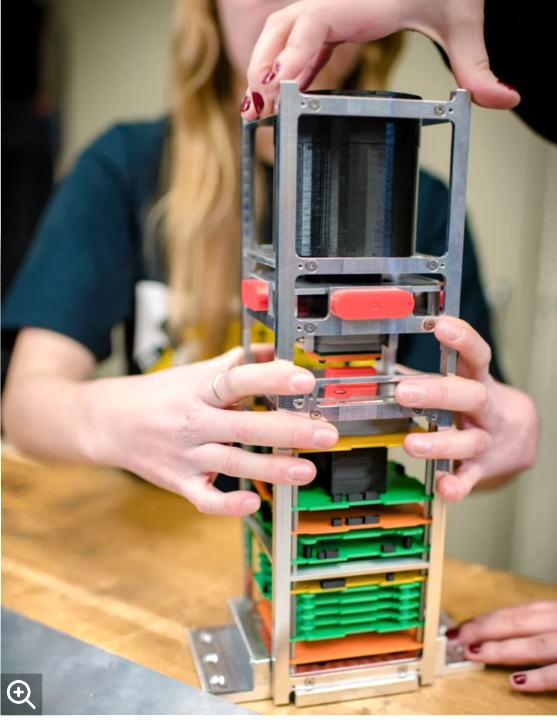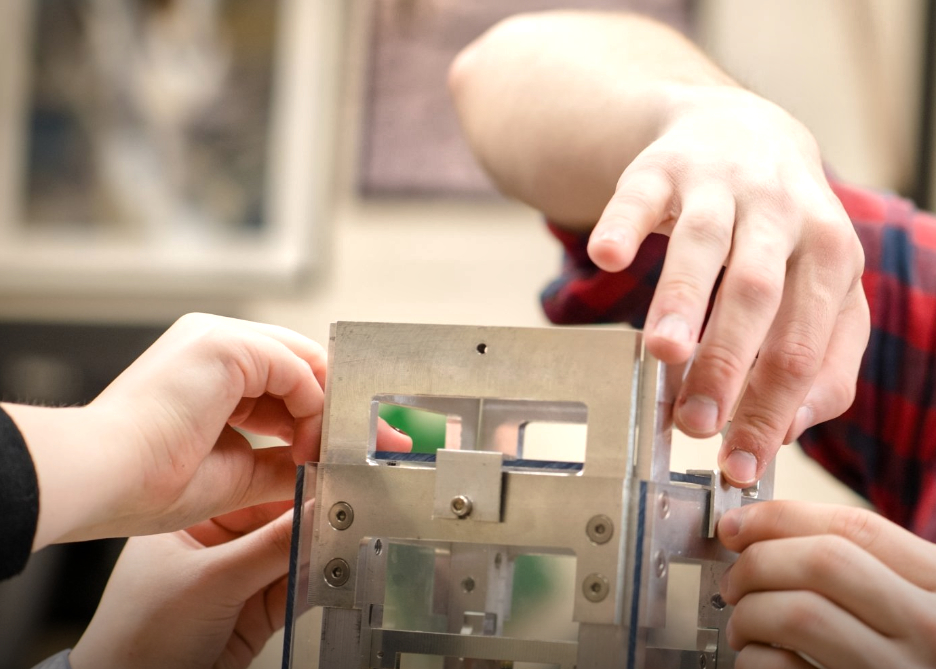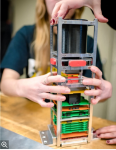
Stratus is a 3U spacecraft, which means the smallsat is composed of three units. This photo was taken in fall 2019 and is courtesy of Michigan Tech University.
NASA has slated Michigan Technological University’s second student-built satellite for a March 2021 deployment from the International Space Station (ISS).
Stratus, named for its cloud-imaging mission, will be carried to the space station, 200 miles above Earth, in a SpaceX Dragon cargo capsule on a Falcon 9 rocket. The Dragon will dock to the ISS.
Brad King, Michigan Tech’s Henes Endowed Professor in Space Systems, who has served as Aerospace Enterprise advisor since students came to him with the idea to form a team nearly two decades ago, said Stratus will be unloaded by the crew and then placed in the Kibo Module’s airlock, where the Japanese Experiment Module Remote Manipulator System robotic arm will move the satellite into the correct position and deploy it into space.
Once successfully deployed, Stratus will be the University’s second orbiting smallsat. The first, Oculus-ASR, was launched from Cape Canaveral in June 2019. Another satellite, Auris, designed to monitor communications emissions from geostationary satellites, has cleared system concept review in the design and development phase of the Air Force Research Lab University Nanosatellite Program (AFRL UNP).
Bill Predebon, J.S. Endowed Chair of the Department of Mechanical Engineering-Engineering Mechanics in the College of Engineering, welcomed the news of a second satellite launch with praise for King and Aerospace Enterprise team members and said it is amazing that Michigan Tech will have a second student-built satellite in space next year. This is a testament to the creativity, ingenuity, and hands-on ability of the students.
Stratus is funded through NASA’s Undergraduate Student Instrument Program and CubeSat Launch Initiative. Michigan Tech’s third satellite, Auris, is funded by the AFRL University Nanosatellite Program.
Stratus will use infrared imagery to gather cloud data that can validate and improve numerical weather models.
Michigan Tech Aerospace Team Program Manager Troy Maust, a fourth-year computer engineering major, has been working on the cubesat project for about a year. He said this mission has been in the works for much longer and, as with Oculus, I estimate more than 200 students and alumni have been part of this mission; it wouldn’t be possible without them.
The 10-by-10-by-30-centimeter, 4.4-kilogram Stratus smallsat is considerably smaller than the 70-kilogram Oculus-ASR, a microsat which measures 50-by-50-by-80 centimeters. But both, as well as Auris, are classed in the broader category of nanosatellites, the craft that represent an important development in space industry trends.
Maust added that, in the past, satellites have been large, multimillion-dollar projects. While large satellites are still being built, there is a shift toward using multiple smaller spacecraft in a constellation. In addition to lowering the overall cost, constellations can provide coverage spread over a larger area. Stratus is an example of using this mindset for weather satellites. All of this will keep everyone busy until the December 2020 handover date.
The COVID-19 global pandemic has affected university access around the world, and Michigan Tech is no exception. Maust said much remains to be done. However, this isn’t the first time the Aerospace Enterprise has contended with unexpectedly condensed timelines. System level testing will take place as soon as campus is able to reopen.
Maust continued that the teams will continue with FlatSat 1 and 2. The names are explanatory and the steps are necessary before the smallsat is entirely assembled. Spacecraft components are laid flat on the workbench and connected to the cubesat’s subsystems to verify that the system works together as a whole.
Maust added that next comes DITL 1 and 2, or Day In The Life. Again, the name is apt, as the tests simulate the actions the assembled spacecraft will perform in a day, with the final test running for a full 24 hours. Vibration and thermal vacuum testing will also be performed to ensure the spacecraft can withstand the harsh conditions of launch and space.
The process of designing, building and flying a spacecraft is multi-faceted, which is why the Aerospace Enterprise, one of the largest at Michigan Tech, welcomes members from disciplines across campus and is organized into numerous subteams. While Stratus system-level testing is taking place, another subteam will be working on procuring any necessary Federal Communications Commission (FCC) and National Oceanic and Atmospheric Administration (NOAA) licensing, which can be a long process and must be started well in advance of launch, as the project will not be allowed to continue without the proper licensing.
In 2016, Michigan Tech was selected to fly Stratus as an auxiliary payload. In early December 2019, a NASA-Goddard Spaceflight Center team conducted a thorough critical design review, or CDR.
Advisor King noted that while a few nicks and dings were suffered from the event, as is common during CDR, the project passed and were able to move on to system integration in preparation for an upcoming launch. Winning the NASA launch was great news, but this celebration was short. Suddenly the ’to-do’ list has gotten a lot longer and the stakes have gotten a lot higher.
Story by Cyndi Perkins, Senior Content Specialist, University Marketing and Communications, Michigan Tech.


